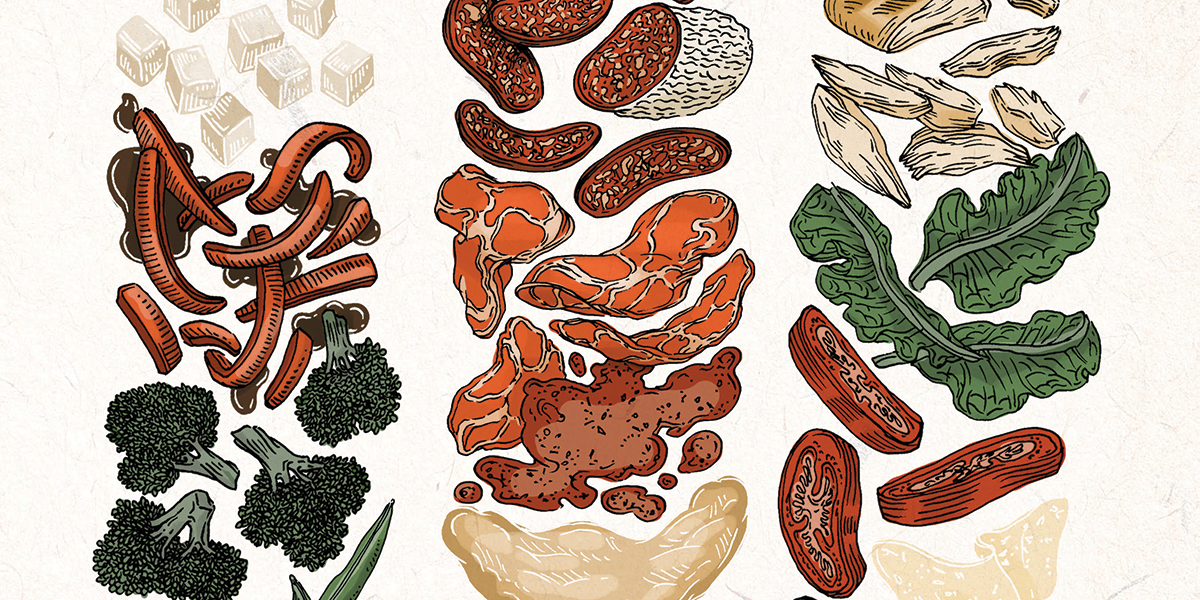For one week in early April, lunchtime diners at North Quad received a new piece of information to consider as they loaded their trays. Along with the calorie count, gluten content, and allergen alerts, each offering included a numeric rating to reflect the food’s carbon impact. The higher the number on the scale, the more sustainable the dish.
The tofu stir fry, for instance, earned a 10. A serving of mini chicken wraps was a seven. The three-meat flatbread pizza landed at five.
In the coming academic year, graduate students in the School for Environment and Sustainability will analyze whether those ratings influenced diners’ food choices. Further menu and information experiments are planned so that by the 2020-21 academic year, Michigan Dining can provide ratings for all of its fare.
The goal is twofold: reduce Michigan Dining’s carbon footprint while encouraging healthier eating. Those two ideas go together in research from U-M Professor Martin Heller, who co-published a groundbreaking, widely hailed paper on the topic in January in the American Journal of Clinical Nutrition. The paper contains the most complete data yet to confirm that food that is better for the environment is also better for people.
“Animal-based foods in general have a larger carbon footprint per serving than plant-based foods,” says Heller, a senior research specialist in the U-M Center for Sustainable Systems, part of the School for Environment and Sustainability. “Where you’re getting your protein makes a big difference.”
Scientists have long known that food production is a major source of greenhouse gases released into the atmosphere and that those gases accelerate climate change by trapping heat in the atmosphere. Ruminant animals, especially cows, emit high quantities of methane, as does rice production. Other practices, including certain fertilizing techniques and the management of animal waste, produce nitrous oxide and carbon dioxide.
In their research paper, Heller and nutrition expert Diego Rose of Tulane University assessed both the carbon footprint and the nutritional value of the diets of more than 16,000 Americans. Those whose foods had the highest carbon impact generally ate larger quantities of foods high in harmful fats, cholesterol, and calories.
“We’re certainly not suggesting that everyone needs to become vegetarian, but thinking about a lot of these food choices is good,” Heller says. “That’s a bit why so often when this discussion comes up in polarized platforms, it gets driven to these extremes that someone wants to take away your hamburgers. Not really. Maybe you just don’t need to be eating a pound of beef every day. And, by the way, your doctor happens to be telling you that as well.”
These findings appeared just days before U-M President Mark Schlissel posted a two-minute video announcing the creation of the President’s Commission on Carbon Neutrality, which is charged with writing a plan by fall 2020 to set the University on a path to carbon neutrality. The Heller-Rose study and Schlissel’s initiative form a powerful one-two punch of momentum for Michigan Dining and researchers across the University.
“What that paper did in particular was put food sustainability in the context not just of climate change but of individual health,” says Alex Bryan, Michigan Dining’s sustainable food program manager. “People care about their health even if they don’t necessarily care about climate change. It connected those two dots in a way that we just hadn’t been able to do yet.”
Early insights from the North Quad experiment show that such labeling had an impact. Michigan Dining conducted the experiment in partnership with the U-M chapter of Net Impact, a network of student groups focused on the intersection of business and sustainable practices. U-M senior Crede Strauser, the project’s co-lead alongside junior Jack Farrell, says the dining hall reported a 5% decline in the consumption of “less sustainable items.”
This initiative is just one way the connections between what we eat and how our diets contribute to climate change have become a major topic of discussion, research, and action at U-M. In early April, the Ross School of Business hosted a one-day conference titled Sustainable Food Procurement By Institutions. There, Michigan Dining director Steve Mangan announced his chefs are reviewing recipes to see what ingredients can be changed to reduce the fare’s carbon footprint. Bryan says that has meant, for instance, offering “blended burgers” that are made up of 40 percent mushroom and renaming some more sustainable, healthier dishes to make them more appealing.
“If we brand something as a ‘vegan burrito’ option, that works really well for the vegans. But if you’re saying it’s a ‘roasted eggplant with poblano pepper burrito,’ it might be vegan and also just sound a lot better to eat,” Bryan says. “We want to use a combination of nudges and changes. We can educate them and help them make a choice. And we can simply change some things over.”
Others in the U-M research community are excited by both the Heller research and the idea that Michigan Dining is taking on this mantle.
“We have these opportunities to see our whole campus as a living-learning laboratory,” says Jeremy Moghtader, manager of the five-acre U-M Campus Farm at Matthaei Botanical Gardens. “How do we use our own campuses to both explore and research and bring into practice more sustainable ways of doing things? That’s the real sweet spot of it all.”
Heller, too, is delighted by how his research is being applied at U-M and beyond.
“The strongest significance of this work is in recognizing and acknowledging that we can make changes to our diets that are both better for health and better for the environment,” he says. “Making changes in those recommendations that further improve health and the environment is a win-win. But part of making that happen was demonstrating that correlation works both ways.”
The study does have limits, Heller acknowledges. Many foods that do not require a lot of carbon release—like those high in sugar—are not healthy. And some dietary recommendations that have small carbon footprints, such as urging people to eat a lot more fish, can create other environmental problems.
“We have to be specific by what we mean by ‘better for the environment’ because when we start to look across a larger number of indicators, we may begin to see more trade-offs,” he says. “But what we know is that animal-based foods in general have a larger carbon footprint per serving than plant-based foods. So we’ve shown that where you get your protein makes a big difference.”
Steve Friess is an Ann Arbor-based freelancer and regular contributor to Michigan Alumnus. The roasted eggplant and poblano pepper wrap sounds really good to him, but so does the three-meat flatbread pizza.





